Beautiful Blue Gems for Jewelry
Suitability for jewelry means that a gem must be tough and durable as well as exceptionally pleasing to the eye.Each of these gemstones share the qualities of beauty and durability, although some, like blue diamond, sapphire and spinel, are tougher than the rest, making them better candidates for blue gem engagement rings and daily wear rings.
Although hardness is not the only indicator for overall gem durability, it is a good clue, and the gems here are listed in order of their Mohs hardness ratings. Traits such as brittleness, tendency-to-fracture, and reaction to temperature impact toughness as well.
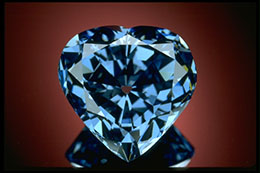
Blue Diamond: Hardest Blue Gem
The toughest blue gem of all, rated Mohs 10, super-sparkler blue diamond is extremely rare and an exceptional gem for any kind of jewelry. Natural diamond is found in many different hues of blue, both light and dark. Most available faceted stones are relatively small, lighter blues, with a grayish cast to the color. Blue diamond is most scarce in large, highly saturated, pure blue color. Expect to pay a premium for any blue diamond.
The blue color is caused by radiation inside the earth. When shopping for a natural diamond, know that treated blue diamonds, irradiated by man, also are available. Treated stones cost a fraction of natural blues.
Diamond is one of a few singly refractive stones, has a very high refractive index, and shows no pleochroism. This characteristic can be useful in distinguishing true diamond from imposter stones.
The rest of the blue gems for jewelry, are collectively described by the Gemological Institute of America (GIA) as "colored stones," or "colored gemstones." Some of the most durable, as well as popular, blue colored gemstones are listed below.
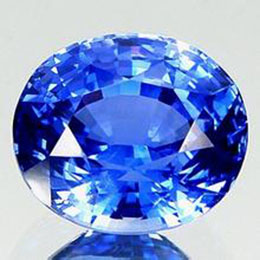
Sapphire: Best-Known Blue Gemstone
Rarer than diamond, and perhaps the best-known and beloved blue gemstone of all time, blue-colored corundum, commonly called sapphire, is an extremely versatile and tough gem suitable for any jewelry application. Sapphire comes in a great range of size, shape, and color – truly, there is something for everyone.
Very intense, highly saturated, pure blue stones of superior luster and transparency are most coveted and extremely pricey. The best of the best are known to come from Kashmir, Burma and Sri Lanka, each with its own unique characteristics. No less beautiful, well-cut, less intense, pastel or complex colors represent a great value.
Rated Mohs 9, sapphire is doubly refractive and shows pleochroism. This extremely durable jewel can handle ultrasonic cleaners and most cleaning applications and conditions.
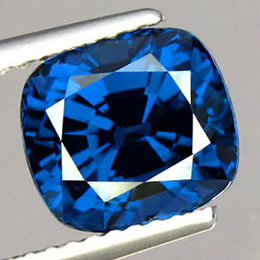
Blue Spinel: Collectors Favorite Gem
Similar in composition to sapphire, blue spinel is a great choice for all types of jewelry. More rare than sapphire, spinel is difficult to find in retail stores. However, the gem is a favorite of collectors and gem cutters due to its color, transparency, brilliance, and glassy luster which is capable of great polish.
Spinel comes in blues of many hues; fine blue spinel appears richly saturated in color as well as transparent, crisp and clear. Lesser-quality stones will show gray masking. Compared to sapphire, blue spinel may appear less intense but may show better brilliance. Unlike sapphire, however, spinel is a totally natural gem that is never treated. Regardless of its exceptional rarity, blue spinel is still less costly than sapphire of equal quality.
Like diamond, spinel is one of a few singly refractive gems. Spinel comes in all sorts of facet patterns, and some specimens may be shallow-cut to lighten overly dark color. Rated Mohs 8, this relatively tough blue gem is safe for most cleaning methods.
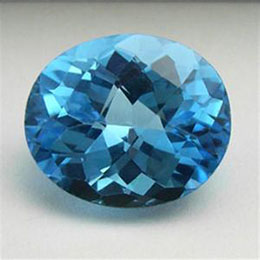
Blue Topaz: Rare Blue Gemstone
Natural blue topaz is a stunning and exceedingly rare gemstone. This versatile gem is highly brilliant, relatively hard (Mohs 8) and very clear. Topaz lends itself to superior polish. Colors are comparable to fine aquamarine, ranging from light blue to dark sky blue (sometimes called London Blue). Unlike aquamarine, topaz has a slightly slippery feel to the touch.
Most blue topaz on the market is actually irradiated and heat-treated colorless topaz. Unfortunately, it is virtually impossible to tell if a stone is treated or not.
Topaz is often step- or scissor-cut and offers good wearability. However, a gem may crack or break if knocked or bumped. Extra care must be taken during polishing and setting, and a protective setting for an often-worn rings is advised. Avoid ultrasonics, steam, rapid change in temperature, and rough handling.
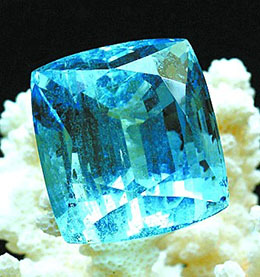
Aquamarine: Popular Pastel Blue Gem
The blue variety of beryl known as aquamarine makes an outstanding jewelry gem. Named for its exquisite, "seawater" colors, aquamarine hues ranges from pale to deep blue, greenish blue and bluish green. The most prized and pricey colors are intense, dark aqua blue. This lovely, versatile gem has a well-earned reputation for gorgeous, clear, evenly distributed color.
In nature, most aquamarine is light bluish green or greenish blue. Most gemstones in the market today are heat-treated to intensify color and to remove any green cast. Heat treatment is acceptable. Buyers pay a premium for untreated, intensely colored stones, such as those from the Santa Maria mine in Brazil. Also, it is quite difficult to find intense, highly saturated colors in smaller stones, hence, a premium may be placed on these rare beauties.
Rated Mohs 7.5-8, aquamarine offers very good wearabiity, although the gems are a bit brittle and can be sensitive to pressure. The hard and brilliant gems are often step-or brilliant-cut in rectangular or oval shapes. It is usually safe to clean inclusion-free gems with ultrasonics.
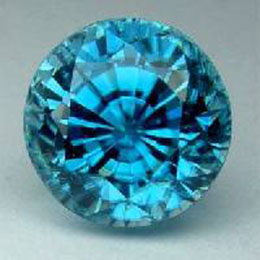
Zircon: Looks like Blue Diamond
If it looks like blue diamond, it may be natural zircon. One of the heaviest of all gemstones, blue zircon shows exceptional transparency, luster and sheen, as well as remarkable diamond-like brilliance and fire. The difference, when compared to diamond, is doubly refractive blue zircon displays strong pleochorism. So, when viewed from different angles, zircon may show distinct blue, yellow-gray or colorless hues. This sparkly gem is often found in brilliant- or mixed-cut gems.
Relatively hard at Mohs 7.5, natural zircon is, however, considered brittle. Hence, rings should be set in protective settings. Also, almost all blue zircon on the market is heat-treated natural brown zircon. Heat-treated stones may appear slightly "artificial" in color and treatment can make gems even more brittle, increasing chances for chipping and abrading. Moreover, heat-treated blues may fade over time especially if exposed to UV light or sunlight. Avoid ultrasonic cleaners.
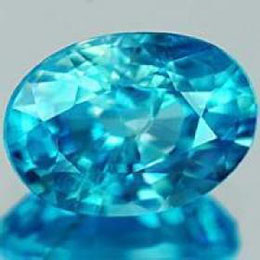
Paraiba Tourmaline: Bright Neon Blue and Blue-Green Gemstone
For lovers of crisp, clear, bright, neon, electric blue and blue-green there is no better gem than Paraiba tourmaline, the exceedingly rare and expensive form of elbaite tourmaline. Discovered in the state of Paraiba, Brazil, during the 1980s, this gem has become so popular that sources are drying-up and prices skyrocketing. Top gems are some of the most pricey of all gemstones, matching prices of finest sapphire.
A similar tourmaline is "Paraiba Africana," a like-colored gem sourced from Africa that is marketed using the well-respected Paraiba monniker. Buyers should distinguish between actual Paraiba tourmaline and Paraiba-type tourmaline. Due to its scarcity, the original Paraiba continues to command highest prices.
Also, Paraiba which is rated a durable Mohs 7-7.5 is sometimes imitated by the similarly colored yet much softer gem called apatite. Apatite is not considered suitable as an unprotected ring gem due to its softness (Mohs 5).
Tourmaline is a very versatile jewelry stone. To prevent fracturing, avoid sudden changes in temperatures. Pyroelectrical characteristics of the gem make it necessary to clean often, however, ultrasonics are considered risky.
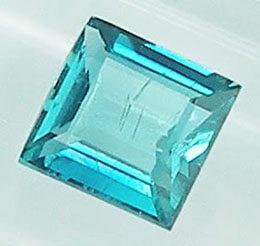
Indicolite Blue Tourmaline: Inky Blue Jewel
Like sister-tourmaline Paraiba, indicolite is an attractive and very versatile jewelry gemstone. This deep to pastel blue tourmaline, usually indigo, inky blue or blue-green, shows high brilliance and is available in very clean material, although you may have to search for the finest gems. Indicolite should be as flaw-free as possible (as IF to VS in diamond clarity grading). High quality indicolite is increasing in value.
Most indicolite has been heated to lighten hue or eliminate objectionable color. The majority of experts do not object to this treatment. However, some indicolite has been heated and irradiated. Generally, irradiated stones are frowned upon because the process adds unnatural color. Any and all treatments should be disclosed. Untreated stones will generally show some sort of color shift when viewed from different angles, whereas treated material may appear more uniform.
Indicolite is available in most sizes and shapes and is a very durable (Mohs 7-7.5) and wearable gemstone suitable for all types of jewelry. Avoid sudden changes in temperatures. Clean often to counter the gem's pyroelectrical characteristics which may attract dust. Ultrasonic cleaning is risky.
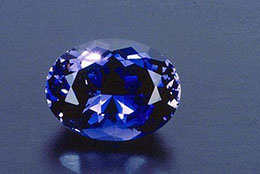
Iolite: The Viking Stone
Called the "Vikings Compass," thin sheets of this natural polarizing material were used for viewing and locating the sun's position during cloudy days on the sea. Usually an irresistible blue, violet-blue or gray-blue hue, iolite is rated Mohs 7-7.5. The gem has a vitreous luster with good brilliance and is normally not treated.
Often, iolite resembles sapphire face-up. In fact, the gem's tendency to look water-like from the side (due to pleochroism) earned it the nickname "water sapphire." However, iolite's very strong pleochorism which shows yellow, dark blue, violet, or pale blue, distinguishes it from look-alike sapphire.
Sometimes considered a less expensive alternative to another look-alike, blue-purple tanzanite, most iolite appears bluer than tanzanite. However, the two gems share a tendency for brittleness and chipping, and both should be worn, cleaned, and stored with care. Avoid ultrasonics and sudden temperature swings.

Comment (0)